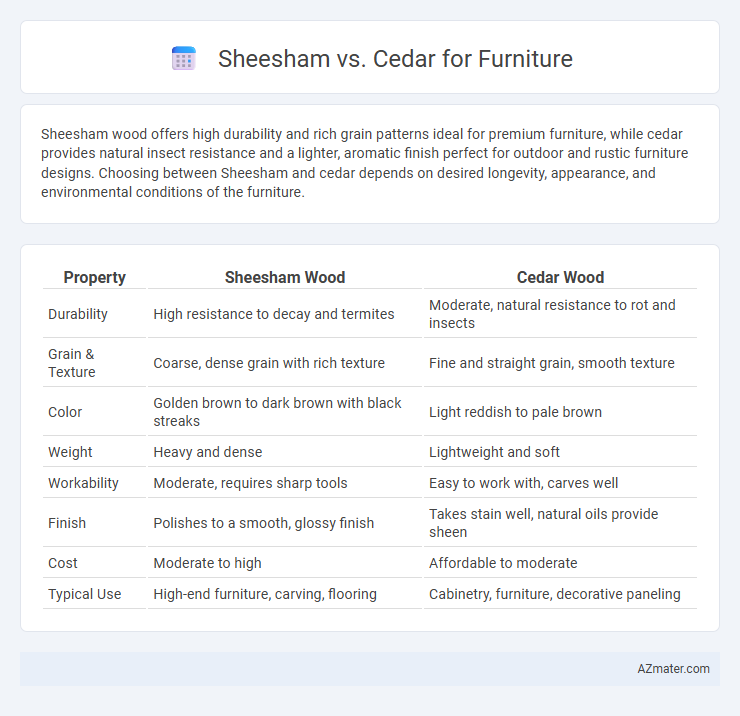Sheesham wood offers high durability and rich grain patterns ideal for premium furniture, while cedar provides natural insect resistance and a lighter, aromatic finish perfect for outdoor and rustic furniture designs. Choosing between Sheesham and cedar depends on desired longevity, appearance, and environmental conditions of the furniture.
Table of Comparison
| Property | Sheesham Wood | Cedar Wood |
|---|---|---|
| Durability | High resistance to decay and termites | Moderate, natural resistance to rot and insects |
| Grain & Texture | Coarse, dense grain with rich texture | Fine and straight grain, smooth texture |
| Color | Golden brown to dark brown with black streaks | Light reddish to pale brown |
| Weight | Heavy and dense | Lightweight and soft |
| Workability | Moderate, requires sharp tools | Easy to work with, carves well |
| Finish | Polishes to a smooth, glossy finish | Takes stain well, natural oils provide sheen |
| Cost | Moderate to high | Affordable to moderate |
| Typical Use | High-end furniture, carving, flooring | Cabinetry, furniture, decorative paneling |
Introduction to Sheesham and Cedar Wood
Sheesham wood, also known as Indian Rosewood, is prized for its rich grain patterns, durability, and natural resistance to decay, making it a popular choice for high-quality furniture. Cedar wood is valued for its aromatic scent, lightweight nature, and excellent resistance to insects and moisture, often used for wardrobes and chests. Both woods offer unique benefits, with Sheesham excelling in strength and aesthetics, while Cedar provides longevity and natural pest protection.
Physical Characteristics of Sheesham vs Cedar
Sheesham wood is dense and heavy with a rich, dark brown hue and distinct grain patterns that make it highly durable and resistant to water and decay, ideal for long-lasting furniture. Cedar wood is lighter, softer, and aromatic with a natural reddish tint, offering moderate durability but superior resistance to insects and rot. The hardness and weight differences affect furniture stability, with Sheesham providing a sturdier build compared to the lighter, more aromatic Cedar.
Durability and Longevity Comparison
Sheesham wood, also known as Indian rosewood, offers exceptional durability due to its dense grain and natural resistance to termite attacks, making it ideal for long-lasting furniture. Cedar wood, while moderately durable and resistant to decay and insects, is softer and more prone to dents and scratches over time compared to Sheesham. For furniture requiring maximum longevity and strength, Sheesham is generally the superior choice due to its hardness and sustained performance in various climates.
Resistance to Pests and Decay
Sheesham wood, known for its natural oils, offers excellent resistance to pests and decay, making it ideal for durable furniture. Cedar contains natural insect-repellent compounds that provide strong protection against termites and fungal decay. Both woods are durable, but Sheesham's denser grain structure often delivers superior longevity in pest-prone environments.
Ease of Workability and Craftsmanship
Sheesham wood is known for its excellent workability, allowing craftsmen to carve intricate details and achieve smooth finishes due to its medium density and natural oils that enhance durability. Cedar, while softer and easier to cut, can be prone to chipping and may require more careful handling to maintain precision in detailed craftsmanship. Choosing Sheesham often results in furniture with finer, more durable craftsmanship, whereas Cedar offers easier shaping but demands skillful techniques to avoid damage during work.
Visual Appeal and Grain Patterns
Sheesham wood features rich, dark brown hues with natural gold and black streaks, creating a striking visual appeal that enhances furniture elegance. Cedar offers a warm reddish tone with a fine, straight grain that adds subtle texture and a smooth surface to furniture pieces. The varied grain patterns of Sheesham make it ideal for ornate designs, while Cedar's consistent grains suit minimalist and rustic styles.
Cost and Availability of Sheesham and Cedar
Sheesham wood is moderately priced and widely available in South Asia, making it a cost-effective option for durable furniture. Cedar, often imported and less abundant, tends to be more expensive due to higher demand and limited supply in certain regions. Availability of Sheesham ensures consistent supply for bulk orders, whereas sourcing Cedar may involve longer lead times and higher shipping costs, impacting overall furniture pricing.
Environmental Impact and Sustainability
Sheesham wood is known for its durability and is sourced from fast-growing trees, making it a more sustainable option compared to cedar, which often comes from slower-growing varieties and can contribute to deforestation. Sheesham furniture production typically involves less chemical treatment due to its natural resistance to pests, reducing environmental pollution. In contrast, cedar requires more frequent maintenance and treatments, potentially increasing its ecological footprint over time.
Maintenance Requirements and Care Tips
Sheesham wood requires regular oiling to maintain its natural sheen and prevent dryness, making it slightly higher maintenance compared to cedar, which naturally resists rot and pests due to its oil content. Cedar furniture benefits from occasional dusting and applying protective finishes to preserve its aromatic properties and color. Both woods should be kept away from excessive moisture and direct sunlight to extend their lifespan and retain structural integrity.
Best Furniture Uses: Sheesham vs Cedar
Sheesham wood, known for its rich grain and durability, is ideal for making sturdy furniture like cabinets, tables, and chairs that require long-lasting strength and resistance to pests. Cedar, valued for its natural aromatic oils and resistance to moisture, is best suited for outdoor furniture, wardrobes, and chests where protection against weather and insects is crucial. Choosing between Sheesham and Cedar depends on the furniture's functional needs: Sheesham excels in heavy-use interior pieces, while Cedar is preferred for its lightweight, weather-resistant properties in outdoor or storage furniture.

Infographic: Sheesham vs Cedar for Furniture
 azmater.com
azmater.com